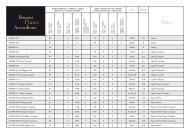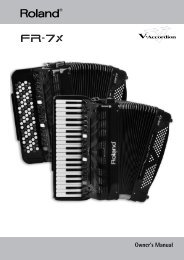USER MANUAL MANUALE D'USO - Castiglione Accordions
USER MANUAL MANUALE D'USO - Castiglione Accordions
USER MANUAL MANUALE D'USO - Castiglione Accordions
Create successful ePaper yourself
Turn your PDF publications into a flip-book with our unique Google optimized e-Paper software.
Important Safety Instructions<br />
CAUTION<br />
RISK OF ELECTRIC SHOCK<br />
DO NOT OPEN<br />
CAUTION: TO REDUCE THE RISK OF ELECTRIC SHOCK, DO<br />
NOT REMOVE COVER (OR BACK). NO <strong>USER</strong>-SERVICEABLE<br />
PARTS INSIDE. REFER SERVICING TO QUALIFIED<br />
PERSONNEL.<br />
AVERTISSEMENT : POUR REDUIRE LE RISQUE DE CHOC<br />
ELECTRIQUE, NE JAMAIS EXPOSER CET APPAREIL SOUS LA<br />
PLUIE OU DANS UN ENVIRONNEMENT HUMIDE. AUCUNE<br />
PIECE CONCERNANT L’UTILISATEUR N’EST A L’INTERIEUR.<br />
POUR LA REPARATION, REFEREZ-VOUS A UN PERSONNEL DE<br />
SERVICE QUALIFIE.<br />
Précaution<br />
Risque du choc électrique<br />
Ne jamais ouvrir<br />
The lightning flash with arrowhead symbol inside an<br />
equilateral triangle is intended to alert User that the<br />
presence of uninsulated "hazardous voltage"within<br />
the product’s enclosure, which may be of sufficient<br />
magnitude to induce a risk of electric shock to persons.<br />
The exclamation mark inside an equilateral triangle is<br />
intended to alert user that the presence of important<br />
operating and maintenance (servicing) instructions in<br />
the literature accompanying the product.<br />
This device complies with Part 15 of the FCC Rules. Operation is subject to the following two conditions: (1) this device may not<br />
cause harmful interference, and (2) this device must accept any interference received, including interference that may cause<br />
undesired operation.<br />
- Read these instructions.<br />
- Keep these instructions.<br />
- Heed all warnings.<br />
- Follow all instructions.<br />
- Do not use this apparatus near water.<br />
- Clean only with dry cloth.<br />
- Do not block any ventilation openings. Install in accordance with the manufacturer’s<br />
instructions.<br />
- Do not install near any heat sources such as radiators, heat registers, stoves, or other apparatus<br />
(including amplifiers) that produce heat.<br />
- Protect the power adapter cord from being walked on or pinched particularly at plugs,<br />
convenience receptacles, and the point where they exit from the apparatus.<br />
- Only use attachments/accessories specified by the manufacturer.<br />
- Unplug this apparatus during lightning storms or when unused for long periods of time.<br />
- Refer all servicing to qualified service personnel. Servicing is required when the apparatus has<br />
been damaged in any way, such as power-supply cord or plug is damaged, liquid has been<br />
spilled or objects have fallen into the apparatus, the apparatus has been exposed to rain or<br />
moisture, does not operate normally, or has been dropped.<br />
- The apparatus shall not be exposed to dripping or splashing and that no objects filled with<br />
liquids, such as vases, shall be placed on the apparatus.<br />
FCC part 15.21<br />
Warning: Changes or modifications to this unit not expressly approved by the party responsible for compliance could void the user's<br />
authority to operate the equipment.<br />
FCC part 15.105<br />
NOTE: This equipment has been tested and found to comply with the limits for a Class B digital device, pursuant to Part 15 of the FCC Rules.<br />
These limits are designed to provide reasonable protection against harmful interference in a residential installation. This equipment<br />
generates, uses, and can radiate radio frequency energy and, if not installed and sued in accordance with the instructions, may cause<br />
harmful interference to radio communications. However, there is no guarantee that interference will not occur in a particular installation.<br />
If this equipment does cause harmful interference to radio or television reception, which can be determined by turning the equipment off<br />
and on, the user is encouraged to try to correct the interference by one or mote of the following measures:<br />
· Reorient or relocate the receiving antenna.<br />
· Increase the separation between the equipment and receiver.<br />
· Connect the equipment into an outlet on a circuit different from that to which the receiver is connected.<br />
· Consult the dealer or an experienced radio TV technician for help.<br />
-6-





